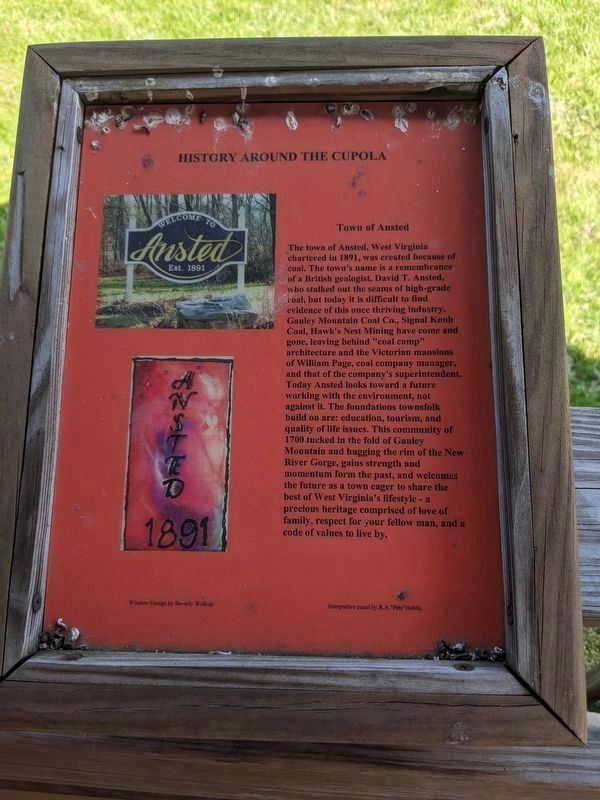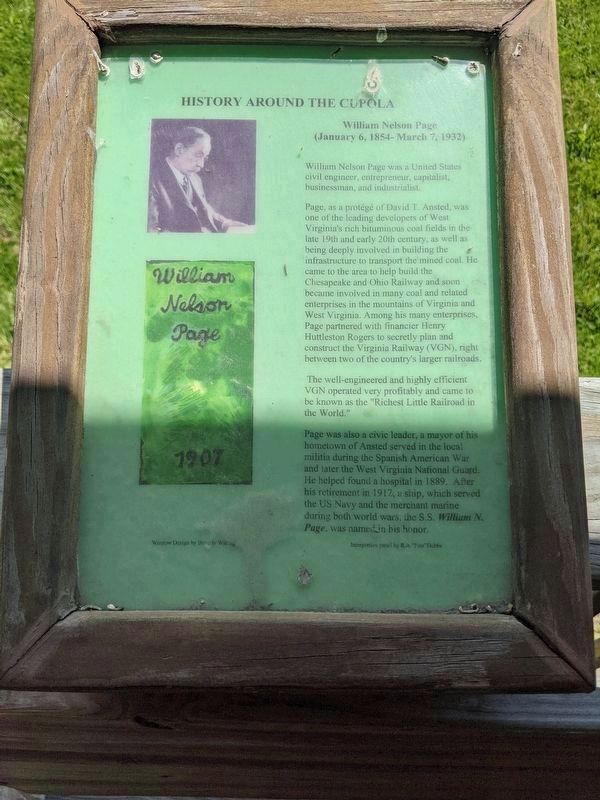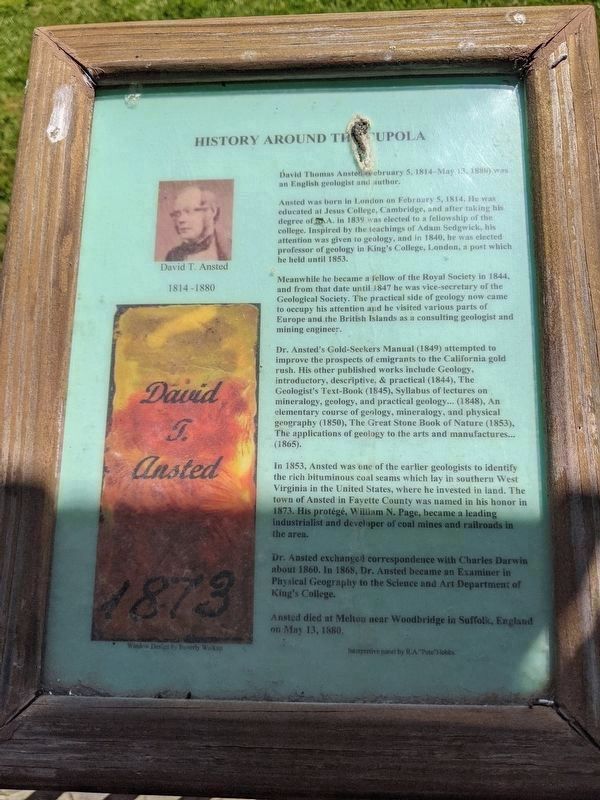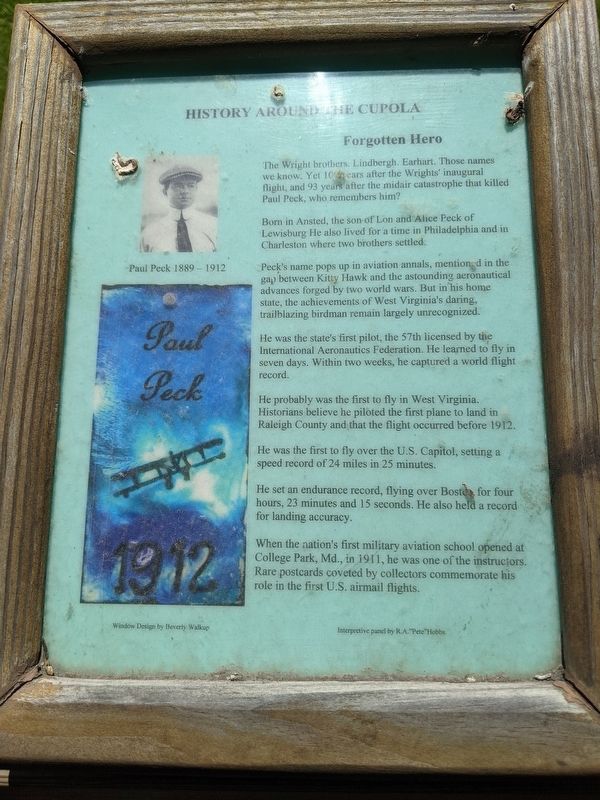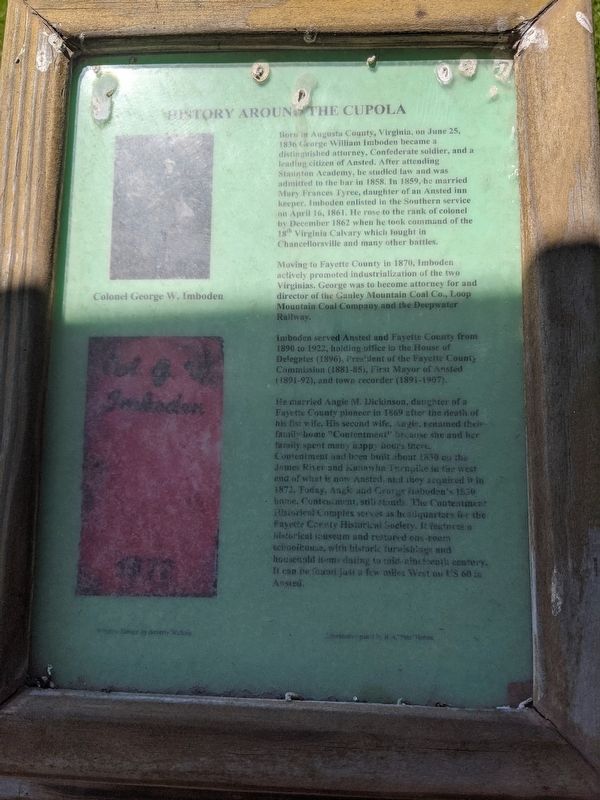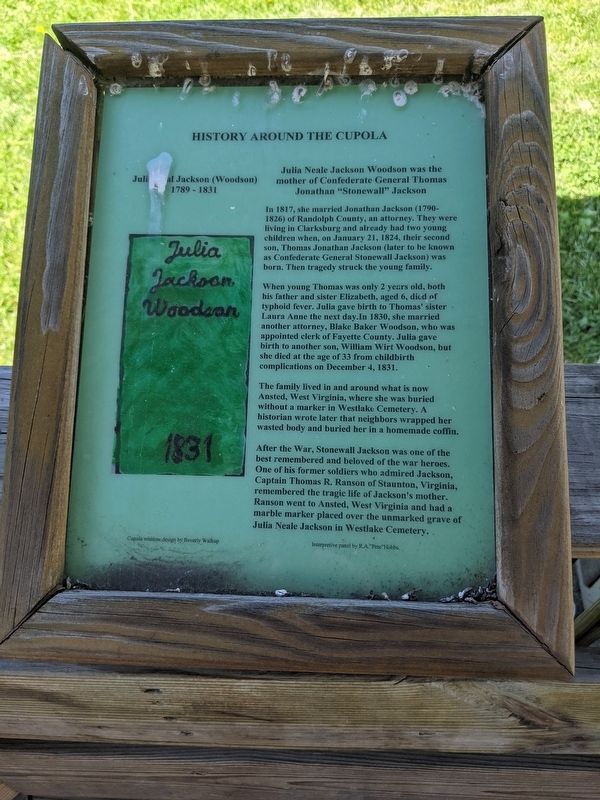Ansted in Fayette County, West Virginia — The American South (Appalachia)
History Around the Cupola
Inscription.
Eight panels mounted to the inside of the town gazebo depict some historical and notable features of the town.
Panel 1 - Town of Ansted
The town of Ansted, West Virginia chartered in 1891, was created because of coal. The town's name is a remembrance of a British geologist, David T. Ansted, who stalked out the seams of high-grade coal, but today it is difficult to find evidence of this once thriving industry. Gauley Mountain Coal Co., Signal Knob Coal, Hawk's Nest Mining have come and gone, leaving behind "coal camp" architecture and the Victorian mansions of William Page, coal company manager, and that of the company's superintendent. Today Ansted looks toward a future working with the environment, not against it. The foundations townsfolk build on are: education, tourism, and quality of life issues. This community of 1700 tucked in the fold of Gauley Mountain and hugging the rim of New River Gorge gains strength and momentum from the past, and welcomes the future as a town eager to share the best of West Virginia's lifestyle - a precious heritage comprised of love of family, respect for your fellow man, and a code of values to live by.
Panel 2 - William Nelson Page
(January 6, 1854-March 7, 1932)
William Nelson Page was a United States civil engineer, entrepreneur, capitalist, businessman and industrialist.
Page, as a protégé of David T. Ansted, was one of the leading developers of West Virginia's rich bituminous coal fields in the late 19th and early 20th century, as well as being deeply involved in building the infrastructure to transport the mined coal. He came to the area to help build the Chesapeake and Ohio Railway and soon became involved in many coal and related enterprises in Virginia and West Virginia. Among his many enterprises, Page partnered with financier Henry Huttleston Rogers to secretly plan and construct the Virginia Railway (VGN), right between two of the country's larger railroads.
The well-engineered and highly efficient VGN operated very profitably and came to be know as the "Richest Little Railroad in the World."
Page was also a civic leader, a mayor of his hometown of Ansted served in the local militia during the Spanish-American War and later the West Virginia National Guard. He helped found a hospital in 1889. After his retirement in 1917, a ship, which served the US Navy and the merchant marine during both world wars, the S.S. William N. Page, was named in his honor.
Panel 3 - David Thomas Ansted
(February 5, 1814 - May 13, 1880)
Ansted was born in London on February 5, 1814. He was educated at Jesus College, Cambridge, and after taking his degree of M.A. in 1839 was
elected to a fellowship of the college. Inspired by the teachings of Adam Sedgwick, his attention was given to geology, and in 1840, he was elected professor of geology in King's College, London, a post which he held until 1853.
Meanwhile he became a fellow of the Royal Society in 1844, and from that date until 1847 he was vice-secretary of the Geological Society. The practical side of geology now came to occupy his attention and he visited various parts of Europe and the British Islands as a consulting geologist and mining engineer.
Dr. Ansted's Gold-Seekers Manual (1849) attempted to improve the prospects of emigrants to the California gold rush. His other published works include Geology, introductory, descriptive, & practical (1844), The Geologist's Text-Book (1845), Syllabus of lectures on mineralogy, geology, and practical geology...(1848), an elementary course of geology, mineralogy, and physical geography (1850), The Great Stone Book of Nature (1853), The applications of geology to the arts and manufactures...(1865).
In 1853, Ansted was one of the earlier geologists to identify the rich bituminous coal seams which lay in southern West Virginia in the United States, where he invested in land. The town of Ansted in Fayette County was named in his honor in 1873. His protégé, William N. Page, became a leading industrialist and developer of coal mines and railroads
in the area.
Dr. Ansted exchanged correspondence with Charles Darwin about 1860. In 1868, Dr. Ansted became an Examiner in Physical Geography to the Science and Art Department of King's College.
Ansted died at Melton, near Woodbridge in Suffolk, England on May 13, 1880.
Panel 4 - Forgotten Hero
The Wright brothers. Lindbergh. Earhart. Those names we know. Yet 100 years after the Wrights' inaugural flight, and 93 years after the midair catastrophe that killed Paul Peck, who remembers him?
Born in Ansted, the son of Lon and Alice Peck of Lewisburg. He also lived for a time in Philadelphia and in Charleston where two brothers settled.
Peck's name pops up in the aviation annals, mentioned in the gap between Kitty Hawk and the astounding aeronautical advances forged by two world wars. But in his home state, the achievements of West Virginia's daring, trailblazing birdman remain largely unrecognized.
He was the state's first pilot, the 57th licensed by the International Aeronautics Federation. He learned to fly in seven days. Within two weeks, he captured a world flight record.
He probably was the first to fly in West Virginia. Historians believe he piloted the first plane to land in Raleigh County and the flight occurred before 1912.
He was the first to fly over the U.S. Capitol, setting a speed record of 24 miles in 25 minutes.
He
set an endurance record, flying over Boston for four hours, 23 minutes and 15 seconds. He also set a record for landing accuracy.
When the nation's first aviation military school opened at College Park, Md., in 1911, he was one of the instructors. Rare postcards coveted by collectors commemorate his role in the first U.S. airmail flights.
Panel 5
Born in Augusta County, Virginia, on June 25, 1836 George William Imboden became a distinguished attorney, Confederate soldier, and a leading citizen of Ansted. After attending Staunton Academy, he studied law and was admitted to the bar in 1858. In 1859, he married Mary Frances Tyree, daughter of an Ansted inn keeper. Imboden enlisted in the Southern service on April 16, 1861. He rose to the rank of colonel by December 1862 when he took command of the 18th Virginia Calvary which fought in Chancellorsville and many other battles.
Moving to Fayette County in 1870, Imboden actively promoted industrialization of the two Virginias. George was to become attorney for and director of the Gauley Mountain Coal Co., Loop Mountain Coal Company and the Deepwater Railway.
Imboden served Ansted and Fayette County from 1890 to 1922, holding office in the House of Delegates (1896), President of the Fayette County Commission (1881-85), First Mayor of Ansted (1891-92), and town recorder (1891-1907).
He married Angie M.
Dickinson, daughter of a Fayette County pioneer in 1869 after the death of his first wife. His second wife, Angie, renamed their family home "Contentment" because she and her family spent many happy hours there.
Contentment had been built about 1830 on the James River and Kanawha Turnpike in the west end of what is now Ansted, and they acquired it in 1872. Today, Angie and George Imboden's 1830 home, Contentment, still stands. The Contentment Historical Complex serves as headquarters for the Fayette County Historical Society. It features a historical museum and restored one-room schoolhouse, with historic furnishings and household items dating to mid-nineteenth century. It can be found just a few miles West on US 60 in Ansted.
Panel 6
The Gatling gun is a ---ty device, originally powered using a crank. A cylinder of ten barrels, spaced equally around the side of the cylinder, rotates around a central axis. Each barrel fires once per revolution at about the same position.
Originally, the Gatling gun was produced in calibres ranging from one inch (25.4 mm) down to 0.45 inch (11.43 mm).
The barrels, a carrier, and a lock cylinder were separate and all mounted on a solid plate revolving around a central shaft, mounted on an oblong fixed frame. The carrier was grooved and the lock cylinder was drilled with holes corresponding to the barrels. Each barrel
had a single lock, working in the lock cylinder on a line with the barrel. The lock cylinder was encased and joined to the frame. The casing was partitioned, and through this opening the barrel shaft was journaled. In front of the casing was a cam with spiral surfaces. The cam imparted a reciprocating motion to the locks when the gun rotated. Also the casing was a cocking ring with projections to cock and fire the gun. Turning the crank rotated the shaft. Cartridges, held in a hopper, dropped individually into the grooves of the carrier. The lock was simultaneously forced by the cam to move forward and load the cartridge and when the cam was at its highest point the cocking ring freed the lock and fired the cartridge. After the cartridge was fired the continuing action of the cam drew back the lock bringing with it the spent cartridge which was then dropped to the ground.
It is believed that the concept for the automatic repeat firing gun was conceived by John Nickol Wood and his brother Marshall Wood. It is known that J.R. Gatlin visited the Wood Brothers in Woodville, (now Ansted, West Virginia) prior to the patent filing.
Panel 7 - Julia Neal Jackson (Woodson)
1789-1831
In 1817, she married Jonathan Jackson (1790-1826) of Randolph County, an attorney. They were living in Clarksburg and already had two young children when, on January 21, 1824, their second son, Thomas Jonathan Jackson (later to be know as Confederate General Stonewall Jackson) was born. Then tragedy struck the young family.
When young Thomas was only 2 years old, both his father and sister Elizabeth, aged 6, died of typhoid fever. Julia gave birth to Thomas' sister Laura Ann the next day. In 1830, she married another attorney, Blake Baker Woodson, who was appointed clerk of Fayette County. Julia gave birth to another son, William Wirt Woodson, but she died at the age of 33 from childbirth complications on December 4, 1831.
The family lived in and around what is now Ansted, West Virginia, where she was buried without a marker in Westlake Cemetery. A historian wrote that her neighbors wrapped her wasted body and buried her in a homemade coffin.
After the War, Stonewall Jackson was one of the best remembered and beloved of the war heroes. One of his former soldiers who admired Jackson, Captain Thomas R. Ranson of Staunton, Virginia, remembered the tragic life of Jackson's mother. Ranson went to Ansted, West Virginia and had a marble marker placed over the unmarked grave of Julia Neale Jackson in Westlake Cemetery.
Panel 8 - William F. Tyree
1808-1883
Probably best known as being the owner of the Tyree Tavern or Halfway House, a stagecoach stop on the old James River and Kanawha Turnpike, Col. Tyree was also active in government. He served various terms as Deputy Sheriff and was Sheriff from 1877 until 1881. In 1837, he was appointed as commissioner to superintend the erection of the County Courthouse in Fayetteville. Col. Tyree served the Confederates as Captain of Co. C 22nd Regiment in which he two sons, Andrew and Joseph were also enlisted. George Imboden, Ansted's first mayor, was Tyree's son-in-law.
The Tyree Tavern still stands today-probably the oldest building in Fayette County. The structure first served as home to Joseph Skaggs, son of Ansted's first settler, Charles Skaggs. It was next occupied by George Hunter, the postmaster, then re-named Mountain Cove. In 1834 Tyree purchased the Halfway House that later served as headquarters during the Civil War for the Chicago Dragoons. General Rosencrans and General Wise at different times had headquarters in this residence. As late as 1927 Mrs. Joseph Tyree then 85 years old, continued to operate the tavern. It is currently a private residence a few blocks east of this location.
Topics. This historical marker is listed in this topic list: Notable Buildings. A significant historical year for this entry is 1891.
Location. 38° 8.127′ N, 81° 5.907′ W. Marker is in Ansted, West Virginia, in Fayette County. Marker can be reached from the intersection of East Main Street (U.S. 60) and Holley Street. Markers are attached to inside rail of town gazebo. There are a total of 8 markers in all. Touch for map. Marker is in this post office area: Ansted WV 25812, United States of America. Touch for directions.
Other nearby markers. At least 8 other markers are within walking distance of this marker. Did You Know? (here, next to this marker); Hawk's Nest Tunnel Disaster (here, next to this marker); William Nelson Page (a few steps from this marker); Hawks Nest Strike (a few steps from this marker); Jackson's Mother (about 300 feet away, measured in a direct line); New Haven Veterans' Memorial (about 400 feet away); Westlake Cemetery (about 600 feet away); Tyree Tavern (approx. 0.2 miles away). Touch for a list and map of all markers in Ansted.
Additional keywords. Notable Persons
Credits. This page was last revised on May 15, 2021. It was originally submitted on May 15, 2021, by Mike Wintermantel of Pittsburgh, Pennsylvania. This page has been viewed 491 times since then and 64 times this year. Photos: 1, 2, 3, 4, 5, 6. submitted on May 15, 2021, by Mike Wintermantel of Pittsburgh, Pennsylvania.
